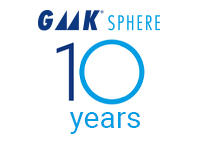-
SIOT, Italian Society of Orthopaedics and Traumatology November 4-7, Rome
-
SOFCOT, French Society of Orthopaedic and Traumatological Surgery, November 9-11, Paris
-
AAHKS, American Association of Hip and Knee Surgeons, November 11-14, Dallas
-
AOA, Australian Orthopedic Association, November 8-10, taking place virtually
-
ISAKOS, International society of Arthroscopy, Knee surgery and Orthopaedic Sports Medicine, November 27-28, taking place virtually
Introduced to the market in 2011, GMK Sphere was developed with the help of worldwide orthopaedic surgeon experts, and it is based on Prof. Michael Freeman and Prof. Vera Pinskerova's investigations of knee anatomy and kinematics [1].
GMK Sphere is a Medially Stabilized Knee designed to provide maximum functional stability while also restoring natural knee motion, with the purpose of improving patient comfort during everyday activities while also reducing postoperative knee pain.
The orthopaedic community has welcomed this innovative implant, and surgeons have chosen it for more than 100,000 patients throughout the world. GMK Sphere is backed by a strong educational network of over 100 international experts, and 10 years of successful clinical experience.
Several published papers, including two studies using advanced 3D moving fluoroscopy technology, have shown that GMK Sphere provides higher stability than other implant designs, while allowing natural and subject-specific motion patterns [2,3,4,5].
Other studies comparing functional and patient-reported outcomes of GMK Sphere and other implant designs have found better results for GMK Sphere [6,7].
More recently, GMK Sphere has shown the potential to improve functional and patient-reported outcomes when combined with Kinematic Alignment, confirming that GMK Sphere is also a very suitable implant for this more personalized technique [8,9,10].
To provide surgeons with the possibility of tailoring implant choice to the patient's needs, Medacta has developed advanced material options:
SensiTiNTM a ceramic-like coating to offer a hypoallergenic solution, and
MectaGrip, a plasma-sprayed titanium coating to achieve primary stability and secondary fixation [
11] in cementless applications.
Additionally, supporting technologies such as
MyKnee®3D printed patient-specific guides and
NextARTM, Augmented Reality Surgical Platform were developed to improve accuracy and precision while preserving healthcare sustainability.
Both MyKnee and NextAR offer a powerful synergy with
GMK Efficiency single-use instruments set. The GMK Efficiency system requires no additional preoperative sterilization and instrument management, optimizing logistics for the surgeon and the hospital, making it the perfect solution for both large hospitals and ambulatory surgical centers. The GMK Efficiency system is also available as part of our Efficiency KneePack, which contains all the components needed to implant the GMK Sphere using a patient-specific single-use instrument set and is delivered sterile in a single, lightweight box allowing to save time in the OR and simplify the OR scheduling.
GMK Sphere is part of the comprehensive GMK System ranging from
GMK UNI for unicompartmental procedures to
GMK Hinge for revision surgery. In particular the system allows very easy transition from GMK Sphere to a semi-constrained (
GMK revision) or a fully constrained (
GMK Hinge) solutions and allows to combine GMK Sphere with revision options like wedges and stems.
The GMK Sphere System is also supported by Medacta's
M.O.R.E. Institute, which offers surgeons ongoing targeted help through a strong education network as they seek to incorporate new technologies. The M.O.R.E. Institute is at the forefront of education for Medacta's procedures and products, with individualized high-level educational routes supporting surgeons with targeted activities and an international network of experienced surgeons.
1 M.Freeman, V.Pinskerova, “The movement of the normal tibio-femoral joint”, J Biomech. 2005 Feb;38(2):197-208
2 Steinbrück A. , Schröder C. , Woiczinski M. , Fottner A. , Pinskerova V. , Müller P.E., Jansson Femorotibial kinematics and load patterns after total knee arthroplasty: An in vitro comparison of posterior-stabilized versus medial-stabilized design. Clinical Biomechanics 33 (2016) 42-48
3 Scott G., Imam M, Eifert A, Freeman M., Pinskerova V., Field R, Skinner J., Banks S., Can a total knee arthroplasty be both rotationally unconstrained and anteroposteriorly stabilised? A pulsed fluoroscopic investigation. Bone Joint Res 2016;5:80–86
4 P. Schütz et al., “Kinematic Evaluation of the GMK Sphere Implant During Gait Activities: A Dynamic Videofluoroscopy Study”, J Orthop Res. 2019;37:2337‐2347.
5 G. Pandy et al., “Comparison of posterior‐stabilized, cruciate‐retaining, and medial‐stabilized knee implant motion during gait”, J Orthop Res. Jan 2020: 1-16
6 Peter F. Choong et al., “A Randomized Controlled Trial Comparing a Medial Stabilized Total Knee Prosthesis to a Cruciate Retaining and Posterior Stabilized Design: A Report of the Clinical and Functional Outcomes Following Total Knee Replacement”, The Journal of Arthroplasty Jan 2020: 1-8
7 Scott D., McMahill B., Patient satisfaction and clinical outcomes are better with a medial-stabilized implant versus a posterior-stabilized implant, International Society for Technology in Arthroplasty (ISTA) 31st Annual Congress, London, England, October 2018. Part 2.
7 D. Jeremic, et. Al, “Short-term follow-up kinematically vs mechanically aligned total knee arthroplasty with medial pivot components: A case-control study”, Orthop Traumatol Surg Res. 2020 Sep;106(5):921-927
8 M. Malavolta, et. Al., “Good clinical results using a modified kinematic alignment technique with a cruciate sacrificing medially stabilized total knee arthroplasty”, Knee Surgery, Sports Traumatology, Arthroscopy 2020AUG
10 Y.Bariv, “Patients undergoing staged bilateral knee arthroplasty are less aware of their kinematically aligned knee compared to their mechanical knee”, Journal of Orthopaedics 23 (2021) 155–159
11 Khanuja HS, Vakil JJ, Goddard MS, Mont MA. Cementless Femoral Fixation in Total Hip Arthroplasty. J Bone Joint Surg Am. 2011;93:500-9.

